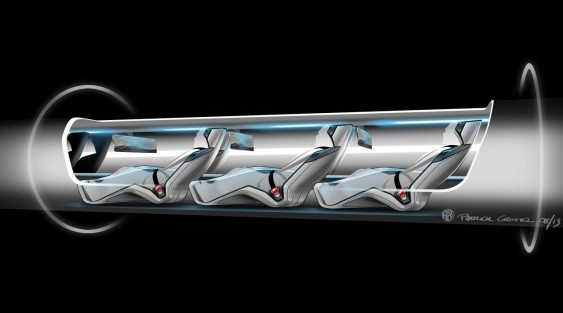By Ana Verayo, | February 01, 2016

Hyperloop passenger capsule version cutaway with passengers onboard.
A winner is finally announced for Elon Musk's design competition for his new hyperloop transport system, where this breakthrough train system will float through air instead on railway tracks, boasting at ultra high speeds, almost near the speed of sound.
Like Us on Facebook
The winners are engineers from the Massachusetts Institute of Technology (MIT) where they have beaten 115 teams from different universities from 20 countries. Elon Musk is also CEO and founder of SpaceX and Tesla Motors.
The MIT design involves aluminum pods where it can contain 20 to 30 people inside that can move through the hyperloop using electromagnets, accelerating at high speeds that are contained inside a metal tube measuring 12 feet in diameter.
Tech billionaire Musk is also an inventor where he describes this project as a cross between a Concorde jet and a railgun travelling on an air hockey table. In theory, the hyperloop can reach supersonic speeds since it can float on air bearings which will not be hindered by any kind of friction. Also, for the comfort of passengers, the hyperloop will not travel at its highest speeds.
There are 22 teams of students who have participated in the contest who are also chosen to help with the next phase of this hyperloop design prototype at the SpaceX headquaters in California this summer. The international teams will be coming from Canada, Germany and the Netherlands.
According to Michael K. Young who is the president of the Texas A & M University, he hopes that everyone who have participated in this prestigious competition can use this momentum to meet other young inventors to innovate and create more, as this competition has already proven that the future is in the good hands of an inspiring and very talented group of young innovators.
The initial plan of the first complete hyperloop system will link between Los Angeles and San Francisco where Musk estimates that the travel time can take just 30 minutes which is five hours less than travelling by car without any traffic.
To date, SpaceX is constructing a test track spanning five miles long from Quay Valley in California to test these initial pod designs. The pods are expected to float on a layer of air that is estimated to be between 0.5 to 1.3 millimeters thick, how a puck hovers over an air hockey table.
Using electric induction motors, this can provide power to the pod when it travels through the tube in an almost zero friction environment during controlled speeds. The current top speed is at 760 miles per hour, where the first track is slated to start operations in 2018.
-
Use of Coronavirus Pandemic Drones Raises Privacy Concerns: Drones Spread Fear, Local Officials Say

-
Coronavirus Hampers The Delivery Of Lockheed Martin F-35 Stealth Fighters For 2020

-
Instagram Speeds Up Plans to Add Account Memorialization Feature Due to COVID-19 Deaths

-
NASA: Perseverance Plans to Bring 'Mars Rock' to Earth in 2031

-
600 Dead And 3,000 In The Hospital as Iranians Believed Drinking High-Concentrations of Alcohol Can Cure The Coronavirus

-
600 Dead And 3,000 In The Hospital as Iranians Believed Drinking High-Concentrations of Alcohol Can Cure The Coronavirus

-
COVID-19: Doctors, Nurses Use Virtual Reality to Learn New Skills in Treating Coronavirus Patients







